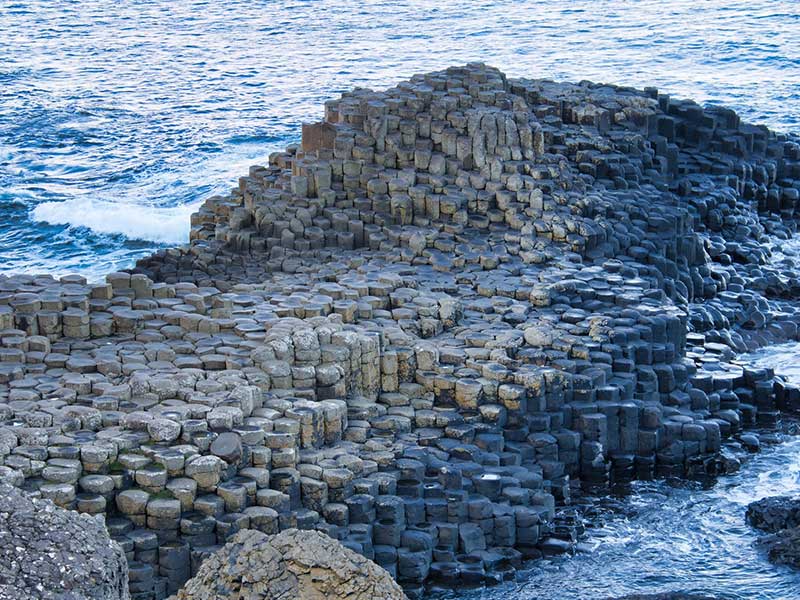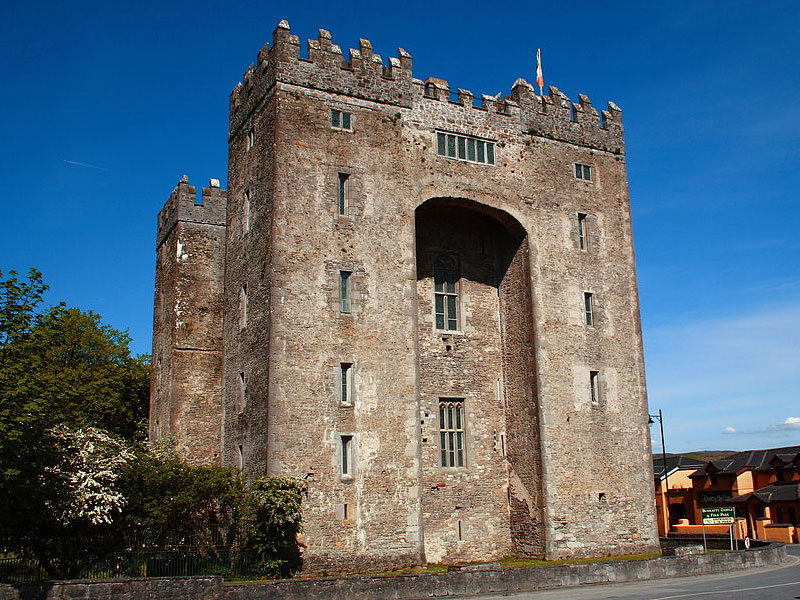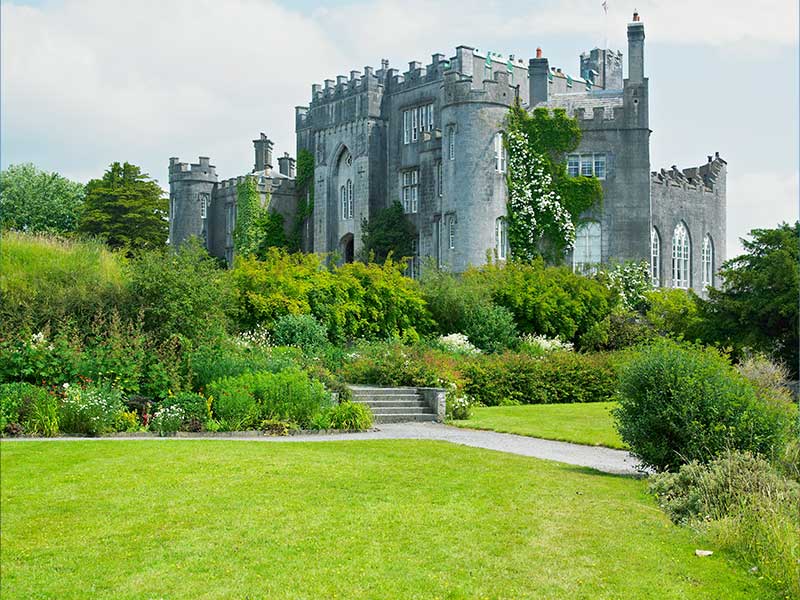
Giant’s Causeway, Co. Antrim.
Follow in the legendary footsteps of giants, such as Finn McCool at Northern Ireland’s iconic World Heritage Site. The famous basalt columns of the Causeway landscape were left by volcanic eruptions 60 million years ago. Its nooks and crannies are dotted with dainty sea campion, and defensive fulmars protect their cliff nests.
Windswept walking trails wind through this area of outstanding natural beauty with an all – accessible walk at Runkerry Head and more challenging terrain along the Causeway Coast Way.
The interactive exhibition and innovative audio – guides, in a range of languages, unlock the secrets of the landscape and regale visitors with legends of giants.
A short distance from the Giant’s Causeway and further along the stunning Causeway Coastal Route is Carrick – a – Rede rope bridge – a truly exhilarating rope bridge experience offering unrivalled cliff and coastal scenery and fantastic bird watching.
Cliffs of Moher and the Burren, Co. Clare
You simply cannot travel to Ireland without paying a visit to one of Ireland’s top tourist attractions, the breathtaking Cliffs of Moher.
Looming over County Clare’s west coast, the cliffs stretch for 8kms and 214 metres over the Atlantic Ocean. Unchanged for millennia, the landscape of the cliffs has for centuries welcomed visitors who come to marvel at their splendour and be at one with nature. The cliffs are home to over 60,000 nesting seabirds and the popular Puffins can be seen from April to July. There are safe pathways to walk and raised viewing platforms for the best views. O’ Brien’s Tower, built in 1835, stands at the highest point where one can view 5 surrounding counties and the Aran Islands on a clear day. The award winning eco friendly visitor centre is set into the hillside and offers an all – weather experience. The Cliffs Exhibition must be seen and brings to life the story of the Cliffs of Moher, presenting the geology, wildlife and human aspects of the cliffs in an entertaining and educational way.
Many visitors to the Cliffs of Moher also avail of the opportunity to visit the Burren which is close by. The Burren is one of the richest archaeological landscapes in Western Europe with over 500 ringforts sitting alongside Neolithic tombs and sacred sites taking you on a journey through the ages. Take a walk through time and be introduced to the ancient mysteries of the Burren, slow down, disconnect and recharge with the powerful energy of the limestone under your feet or stroll through the hedgerows of native Irish trees.
Rock of Cashel, Co. Tipperary.
The Rock of Cashel is one of Ireland’s most visited sites, and is a spectacular site displaying a collection of medieval ecclesiastical buildings set on an outcrop of limestone in the Golden Vale. The 12th century Round Tower is the oldest surviving building on the Rock. The 13th century Gothic cathedral is a large cruciform Gothic church built between 1230 and 1270. But the jewel in the crown of Rock of Cashel is undoubtedly Cormac’s Chapel. Cormac’s Chapel is one of the earliest and finest churches built in the Hiberno – Romanesque style.
The site also includes a 15th century Tower House and the Hall of the Vicars which is the entry point to the ecclesiastical enclosure.
The Rock of Cashel is located just 500 metres from the centre of Cashel Town.

House of Waterford Crystal, Waterford.
Located in the heart of Waterford City, the house of Waterford Crystal allows visitors to witness the creation of crystal stemware, giftware and masterpieces right before their very eyes.
The factory tour is a unique and captivating experience that is sure to enthral visitors of all ages, both national and international. Go behind the scenes for over an hour and see exactly how Waterford Crystal pieces are made – witness every stage of production, from the initial design stage right up to the final engraving of the piece.
Since the House of Waterford Crystal manufacturing facility and brand experience opened at its new location in June 2010, it has welcomed over 1 million visitors into its haven of crystal and innovation.
The Jameson Distillery, Midleton, Co. Cork.
Jameson was born and raised in Dublin, but eventually outgrew its city home on Bow St. In 1975, Jameson moved it’s entire whiskey making operation to the green surroundings of Midleton, Co. Cork. The original buildings at the impressive 15 acre Midleton Distillery site date back as far as 1794 and have been used to distil and mature whiskeys since 1825.
To this day, every drop of Jameson enjoyed around the world originates from the Jameson Distillery, Midleton.
For those just acquainting themselves with the world of Irish whiskey, the Jameson Experience guided tour is the perfect place to start. If you want to dive deeper into the production process – the Behind the Scenes Tour, Premium Whiskey Tasting or Irish Whiskey Academy will certainly quench that thirst. There is something for everyone.
Guinness Storehouse, Dublin.
Guinness is synonymous with Ireland and no visit to Dublin is complete without a trip to the Guinness Storehouse – the Home of Guinness.
Located in the heart of the legendary St. James’s Gate Brewery in Dublin, this production site has been home to the Guinness Brewery since 1759, when Arthur Guinness signed a lease for 9,000 years. The Guinness Storehouse building dates back to 1904 and is built in the style of the Chicago School of Architecture. It was once the fermentation plant of the brewery and is now a seven-storey visitor experience dedicated to the history of the making of this world famous beer.
The Guinness Storehouse is the Home of Guinness, where you will discover what goes into the making of each and every pint, and learn about the incredible brand history stretching over 250 years.
One of Ireland’s most popular International Visitor Attraction unfolds its tale across seven floors shaped around a giant pint, which, if filled would contain 14.3 million pints of Guinness.
Here, you can experience Guinness like nowhere else. As you make your way through the impressive storehouse, discover the age-old art of brewing that makes Guinness so distinctive; visit the Tasting rooms, a multisensory tasting experience designed to help you appreciate the distinctive taste of the iconic stout, from the very first velvet sip to the last lingering drop.
You can learn how to pour the perfect pint in the Guinness Academy or upgrade to enjoy samples of the four most popular variants, with an intimate tasting experience with the Connoisseur Experience. Step into the wonderful world of Guinness Advertising at the new Advertising Exhibit. Enjoy the best in Irish cuisine at the Guinness & Food Experience on level five.
The highlight for many visitors is the Gravity Bar, symbolically the ‘Head of the Pint”, where visitors can enjoy unparalleled panoramic views of Dublin city – views that are all the better with a complimentary pint in hand.
Christ Church Cathedral, Dublin.
Located at the heart of Dublin city, Christ Church Cathedral has been a place of worship for 1,000 years. The history of Christ Church reflects the history, both religious and political, of Ireland. The Crypt is the largest in Ireland, and dates back to the 11th century. The Cathedral’s own copy of Magna Carta is on display there, alongside priceless silverware and the costumes from the hit TV show – the Tudors – and a mummified cat and rat.
Music forms a very important part of cathedral life and the Choir traces its origins to 1493 with the founding of the choir school. The cathedral choir performed the first performance of Handel’s Messiah in Dublin in 1742. Visiting Musicians often perform lunchtime recitals at 13.15 in the nave.
The cathedral’s deployment of 19 bells, ranging in weight from a quarter of a ton to two and a quarter tons, represent a world record of numbers of bells available for full circle ringing.

Irish National Stud & Japanese Gardens, Co. Kildare.
From horses to horticulture the Irish National Stud & Japanese Gardens is one of Irelands true treasure.
The Stud Farm is the home to equine royalty, immaculately bred stallions who can be seen and admired alongside protective mares, frolicking foals and athletic yearlings.
In the world famous Japanese Gardens, you can follow the path called the ‘Life of Man’ which traces the passage of a soul from birth to death, at the same time providing a meeting place for the cultures of East and West .
St Fiachra’s Garden symbolises the power of the Irish landscape while the Horse Museum includes the skeleton of the legendary Arkle
See retired equine stars like Hardy Eustace, Kicking King, Rite of Passage, Beef or Salmon and Hurricane Fly on the Studs ‘Living Legends’ team.
Enjoy this unique experience as a part of a guided tour or at your own leisure.
Blarney Castle & Gardens, Co. Cork.
Situated 8kms from Cork City, this historic castle is most famous for its stone, which has the traditional power of conferring eloquence on all who kiss it. The word ‘Blarney’ was introduced into the English language by Queen Elizabeth I and is described as pleasant talk, intended to deceive without offending. The stone is set in the wall below the battlements. To kiss it, one has to lean backwards (grasping an iron railing) from the parapet walk.
In the grounds of the castle, the Rock Close is a curious place of ancient trees and far more ancient stones, by legend a garden of a druidic origin and a centre of worship in pre – Christian days.
The place has an aura of magic and mystique with Wishing Steps, Witch’s Kitchen, Druid’s Cave and many other delights, telling a story of centuries past. Blarney Castle Estate offers visitors the chance to stroll through one of the country’s most spectacular gardens.
Blarney Castle & House are set in acres of parkland filled with rare and unusual trees and plants. There is a fern garden with the atmosphere of a tropical jungle, a poison garden full of deadly but fascinating plants, an 80 metre long double herbaceous border and rose pergola, extensive rhododendron beds and spring bulbs.
Titanic Belfast.
Titanic Belfast, recently crowned as the World’s Leading Tourist Attraction is a ‘must see’ visit on any tour of Belfast and Northern Ireland. It is located in the heart of Belfast, right beside the historic site of this world famous ship’s construction.
Titanic Belfast is an iconic six floor building, featuring nine interpretive and interactive galleries exploring the sights, sounds and stories of Titanic exhibition.
The adventure begins the moment you walk into the building’s giant atrium, surrounded by the four ‘hull’ shaped sections which house the experience. As you wander through Titanic Belfast, you’ll learn about Belfast at the turn of the 20th century and experience a thrilling ride through a reconstruction of the shipyard as Titanic was under construction. Be brought deep into the stories of the passengers, the crew and the heroes of the day; relive the drama of the tragic end to Titanic’s maiden voyage, and visit the wreck at her resting place on the floor of the Atlantic. Finally, walk the decks of SS Nomadic, the last remaining White Star Line vessel and the biggest Titanic artefact in the world, and see what life was like for passengers and crew on board. Enjoy breath – taking views of the slipways where Titanic was launched.
Cobh Heritage Centre, Co. Cork
The Queenstown Story, is a self guided tour, relaying the tales of Emigration to North America, transportation of Convicts to Australia, ‘The Forgotten Irish’ the story of the Irish indentured servants in the West Indies, and of course the Titanic and the Lusitania disasters. These subjects are dealt with as you walk through the exhibition.
It is a very moving, educational, interesting and emotive way to spend an hour – ‘walking in the footsteps of our ancestors’ who left these shores and whose last sight of Ireland was the town of Cobh.
The exhibition is full of stories and history and gives visitors the opportunity to explore this rich historic past and engage with the stories told.

Bunratty Castle and Folk Park, Co. Clare.
Ireland’s iconic Bunratty Castle is a must on your visit to Ireland. Named after the river Raite which runs along side this strategic battlement. The spot on which the castle stands has been occupied for over 1000 years be the the Vikings, the Normans, great Irish Earls and noble Lords and Ladies. Graciously restored in the 1960s and furnished with Lord Gort’s magnificent collection of medieval furniture and furnishings, this is your chance to experience a window to Ireland’s past and explore the acclaimed 15th century Bunratty Castle.
Set on 26 acres, the impressive Folk Park features over 30 buildings in a ‘living’ village and rural setting. Rural farmhouses, village shops and streets are recreated and furnished in keeping with the lives and times of their ancient owners. When you visit Bunratty’s 19th Century Folk Park you experience a reconstruction of various homes from the poorest one room dwelling to Bunratty House, a fine example of a Georgian residence built in 1804.
Belvedere House & Gardens, near Mullingar, Co. Westmeath.
Lord Belvedere’s Hunting Lodge beside Lough Ennell stands on 160 acres of maintained estate, punctuated with numerous follies, the largest being The Jealous Wall built to obscure his brother’s larger house. Belvedere House has been fully restored and is noted for its exquisite rococo ceilings and bow end design. The Victorian Walled Garden exercises all the senses with a fragrant herb garden, old rose beds, tumbling herbaceous borders, alpines, climbers and vegetable potager. Belvedere plays host to a range of different outdoor events, including Garden Theatre, Bird Walks, Bat Walks, Music Concerts and Dog Shows.
Foynes Flying Boat Museum, Co. Limerick.
The role played by Foynes in the establishment of passenger flights across the Atlantic is excitingly captured in the Museum, which is located in the original Airport Terminal Building. Foynes was the first International Airport in Ireland and operated right through the 2nd World War. The famous flying boats were frequent visitors carrying a diverse range of passengers including military personnel, celebrities and refugees.
Foynes and the flying boats will be forever connected with the invention of Irish Coffee as they combined to give us this uniquely Irish treat. In 1943, Chef Sheridan spent months perfecting one of the world’s most famous tipples to be served to weary and cold passengers. A wonderful 3D hologram re – enacts this historic event in the very building of its creation, and you can enjoy an Irish Coffee in a beautiful 1940s setting.
Explore the wide – ranging maritime and interactive displays depicting life on the River Shannon and enjoy the panoramic view of Foynes from the tip of the Control Tower.
Muckross House & Gardens, Killarney, Co. Kerry.
Discover for yourself the magic of Muckross, with something to appeal to all ages. The world renowned Muckross House is situated amidst the spectacular scenery of Killarney National Park. Visit the elegantly furnished rooms, which portray the lifestyles of the Gentry and downstairs experience the working conditions of the servants employed in the house. Both Muckross House and Traditional Farms are fully accredited museums.
Relive the past at Muckross Traditional Farms complete with three working farms from Kerry of the 1930s. Meet the Bean an Tí and watch the farmer at work in the fields. Children will love the arm animals and play area.
Take a trip around Muckross Estate on one of the many Jaunting cars. Enjoy the history, legends and folklore of the area and some Irish wit as you experience Ireland’s most traditional mode of transport.
Don’t forget to have a ramble in Muckross gardens and enjoy the freedom of the many Nature Trails in Killarney National Park.

Birr Castle & Science Centre, Co. Offaly
The stunning gardens at Birr Castle are home to unending botanical marvels with an abundance of exotic flora to be found throughout along with feats of scientific and engineering wonder for all to view and enjoy.
Explore the gardens, which are home to the Great Telescope, once the largest in the world created by the third Earl of Rosse in the 1840s along with Ireland’s largest tree house and adventure area. The award – winning millennium formal gardens, surrounded by the romantic hornbeam cloister walk, proudly houses the world’s tallest box hedges and includes plants exclusive to the gardens. The 120 acres of gardens house an impressive plant collection of rare species from around the world, including over 40 trees published as champion trees of Britain and Ireland.
The historic science centre transports visitors back to a time when Birr Castle was a hub of scientific discovery and innovation. The interactive galleries reveal the wonders of early photography, engineering and astronomy.
The castle, a family home since the 17th century, opens its doors during the summer months for guided tours offering visitors the chance to visit this private residence.